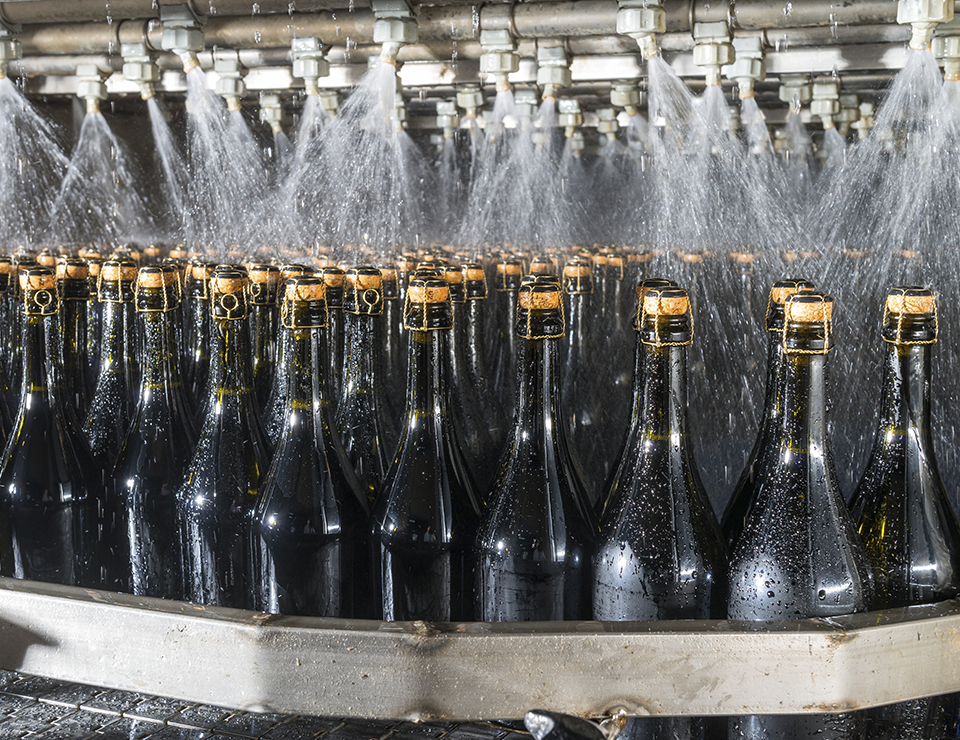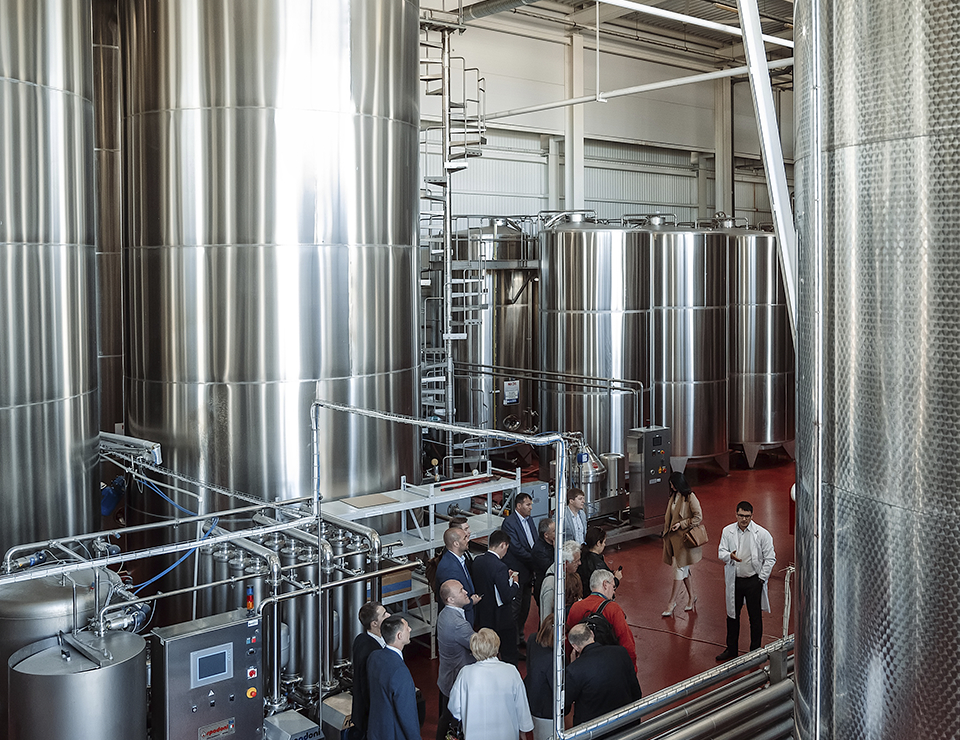Production
The winery "Kuban-Vino" works on the principle of producing a full cycle: the berries harvested on their own vineyards are directly reclaimed from the vines. Today, Kuban-Vino is three own production sites (in Taman, Temryuk and Starotitarovskaya) and 56 million bottles of quiet and sparkling wines per year. Unprecedented scale even for European winemaking.
Since 2015, Kuban-Vino has been cooperating with enologist-consultants of Enofly (Italy), which allows using the experience and traditions of Italian winemaking to create new lines.
But it's not just the scale, but also the approach to production: it's a modern, technological, and even science-intensive process. The newest European equipment, the best specialists, trained and trained in Europe, perfected technology of each link of the production chain - all this allows creating worthy, high-quality wines.
Where does the creation of wine begin? Of course, with the collection of grapes.
Mass harvesting of grapes begins when they reach technological maturity. Two weeks before the collection of grapes begins control of its maturation. Average samples of grapes are checked in the laboratory at the winery. The grapes are harvested by hand and harvester. The machine when harvesting grapes replaces up to 100 people. At the moment, there are 12 combines of the French company Gregoire. & Nbsp; & nbsp; The main way of delivery of grapes to the plant is a bulk transportation using "Lodochki" grape containers. Grapes must be delivered to the plant no later than 4 hours after collection, as the juice that flows from the damaged berries easily ferments and oxidizes. Grapes are harvested when white varieties are saccharified 19-20 g / dm3, red 22-26 g / dm. The processing of grapes is carried out in a soft mode, completely eliminating rubbing of the skin and seeds, as well as crushing crests.
Primary processing
Entering the plant grapes arrive at the reception point, where it is weighed on the car scales. Then the average sugar content is determined by an automatic sampler. Then the grapes are unloaded into the receiving bunkers - feeders of the seven acceptance lines. Bunkers with a capacity of 1 to 15 tons, equipped with 2 augers. From the bunker the grapes are fed with a screw to the crushers - the crest of the roll type separator "KARRA-25" with a capacity of 25 t / h.
The crushing of berries is made in order to facilitate the isolation of juice and increase its yield. Separation of combs from berries is compulsory. Grape clusters enter the crusher, where the horizontal shaft rotates, special berths beat off the branches from the branches and come down the crushers - the mesenter. Then the pulp is pumped through a pipe for pressing. The plant has 7 pneumatic presses with a capacity of up to 60 tons .
Each of the presses is equipped with an automatic control panel. Processing of grapes is carried out according to one of 9 programs (5 for white varieties, 4 for red ones). Each of the programs consists of 4 cycles: (filling, pressing, unloading, washing). In the mode of filling the pulp through the pipeline enters the press, as it is filled, the wort is automatically pumped out. The process of accumulation lasts about 3-6 hours, depending on the receipt of grapes for processing from fields. After filling and draining, the pressing mode is activated. Pressing of grape berries is made by a special membrane made of food rubber, which is supplied with compressed air. When the process eliminates the grinding of grape seeds, this makes it possible to obtain a must with a low content of suspensions. In total, 5 different pressure levels (with increasing) are applied to the membrane. The wort in the pressing mode is automatically divided into fractions, using a special channel. So the wort after the first 3 levels of pressure combines with gravity, and the last two are pumped to separate tanks. After the pressing mode is completed, the membrane presses are unloaded according to a special program. It lasts for 30 minutes. The press is equipped with a special hatch, which gradually opens and the squeeze out of the drum pours out into the conveyor and is sent to a hopper to collect pomace. After the end of the unloading, the automatic cleaning according to the special program is performed by the time this process takes 30 minutes. And the wort is sent to storage tanks, where it is cooled down to t 10-12 С and the day is settled.
Production of red wines
For the preparation of red wines, the collected and sorted grapes are delivered for processing. The gap in time between collection and processing of grapes should not exceed 4 hours. Crushing and comb separation is carried out according to the generally accepted scheme. The resulting pulp is sent to the vinificators for fermentation. Fermentation is carried out on pure yeast cultures, which are preset in an amount of 1 g / dal. The floating cap in the tanks is systematically mixed, transferring the lower layers of wort to the surface of the cap for better exposure of the coloring substances from the grape skin. Fermentation is carried out at t 25 C. During fermentation, the temperature and quantity of fermented sugars are systematically monitored, as well as the state of microflora.
Vinificators are equipped with cooling shirts. The purpose of infusion on the mash is to enrich the mash with aromatic and coloring substances extracted from the skin and pulp of berries. After fermentation, the fermented red must is removed from the vinificator, and the glass mash through the lower hatch is unloaded into a screw container and fed to a press. As the press is filled, the pumping of fermented fermented wine is automatically pumped out. The processing of wine materials is carried out in technological tanks, which after completion of the after-fermentation are supplemented. At the end of alcoholic fermentation, apple-milk fermentation is carried out using a pure culture of bacteria. After the end of the process of malolactic fermentation, the clarified wine material is removed from the precipitate with 25 mg / dm3 sulphation and, if necessary, by eagalization to obtain homogeneous batches.
The fermented wine materials are constantly refilled and stored in conditions that exclude the possibility of oxidation and the development of pathogenic microorganisms. After fermentation, the wine materials are stored at t 10-16 С.
Production of white wines
For the preparation of white wines, the collected and sorted grapes are delivered for processing. The gap in time between collection and processing of grapes should not exceed 4 hours. Crushing and combing is carried out according to the generally accepted scheme. Then the pulp enters the press.
RETRACTING
After completion of the pressing mode, the wort is fed to the slop compartment. The new branch was put into production in 2011. This is more than 80 containers in volume of 2.7 -3.7 thousand decalitres. The wort is cooled to t 10 -12 degrees and left to stand in a cooled state. In the process of sludge in the tank is set bentonite - natural clay. After separation of precipitation, clarified wort is fed to fermentation. Wort clarification is carried out in order to remove contaminant particles of grape must, as well as wild microflora from it. That contributes to the reduction of wort oxidation. From the quality clarification of the wort depends the quality of the future wine. And also this process positively influences the course of fermentation and aroma formation. Clearing by settling is most widely used for clarifying wort before fermentation.
FLOATING IN A FACTORY SETTING
In the press compartment, two flotation plants of the Italian company are set up, which are intended to lighten the wort before fermentation begins. The settings work in-line. The wort from the accumulators is fed to the entrance to the flotation plant, the calculated amount of coating materials (gelatin, bentonite) is dosed into the flow, then the mixture is saturated with an inert gas and supplied to a drum with a volume of 3000 dal. Suspension sediments with air bubbles rise upwards. The thicket from the surface is collected by means of special suction devices, continuously rotating in a circle. The clarified wort with the help of the pump is pumped to fermentation, and sediments are fed to the filtration compartment of precipitation. One unit per hour of operation clarifies 3000 wit.
FERMENTATION
Alcohol fermentation is the main technological process of winemaking. The clarified must is fed to fermentation batteries. The plant has 7 fermentation lines for the preparation of wine material from white grapes. Each line is 6 fermentation tanks connected in series, the first is given to wort, yeast (produced in France, Italy) and at a certain temperature for 12-14 days, fermentation occurs. During wort fermentation, the temperature is regulated within the limits of 16-19, in order to avoid loss of aromatic substances. After the complete cessation of fermentation, the young wine material is sent for storage. During storage, containers are periodically topped up, at least once a week. Young wine material & nbsp; & nbsp; are subjected to further treatments, in order to impart to them a spill resistance. The settling clarification is carried out in order to separate the clarified wort from the wort and yeast precipitate. The clarification process proceeds continuously. Low storage temperatures promote a faster process. In this case, a natural fall of the tartar can occur. The clarification process lasts 14-18 days.
PRESS CENTER
To extract the liquid phase from the sediments, a vacuum drum filter of the brand TAYLO LUX 30, manufactured by the Italian company PADOVAN.
Before the filtration or spinning process, an aqueous suspension of a volcanic powder filter powder, perlite, is prepared. This occurs in a special tank equipped with a stirrer. Vacuum filter is a drum, covered with a metal mesh, equipped with a vacuum pump and a bath for precipitation. Firstly, a layer of filtering powder is wound on the drum 10 cm. After downstairs, the sludge or yeast precipitates are fed into the bath, or glutinous - the wine material or wort is sucked into the drum, and the sediments remain on the surface. They are cut with a special knife. After the removal of precipitation, the young wine material is sent to the shop for storage and processing of wine materials.
VENEERING
In the wine store there are metal containers made of food grade stainless steel, which allow carrying out various technological operations. They are equipped with detergents, which allow cleaning the container within one hour. In the tanks, the storage of wine materials and partial technological processing are mainly carried out - blending, pasting, filtration, aging and rest.
The laboratory carries out input quality control of raw materials, auxiliary materials, manufactured products at all stages of production. And also gives recommendations on the maintenance of the technological process. In addition to the usual methods of analysis, laboratory tests are carried out on modern instruments. The equipment of the laboratory allows solving all tasks in a very short time. Within 30 minutes the chemical analyzer determines 20 basic parameters of the wine in 84 samples. One of the main methods of controlling the output is technological microbiological. Wine materials, water used for cleaning equipment, and process containers.
Production of sparkling (champagne) wines
In Taman, Chardonnay, Pinot Noir, Riesling, Sauvignon, Pinot Blanc, Aligote, Cabernet Sauvignon, Traminer are grown for the production of sparkling wine. Of course, these varieties are not chosen by chance. It is very important that the Champagne wine material has the potential of surface-active substances, which are responsible for the combination of frothy and sparkling properties in a ready-made sparkling.
For the preparation of sparkling wines of the premium class, only the most delicate portion of the grapes' juice goes. There is a notion of "must wort". This is when the must (the crushed grape berry, separated from the stone and peel - gives away its juice) drains itself without any effort. Modern technology implies an easy effect on the grapes, in which the separation of the juice occurs by gravity. This juice contains the finest substances that have passed into the juice of the grapes. For one bottle of this wine, you need to spend about 1.5 kg of grapes. A vivid example of the use of just such a technology is a mature sparkling "Aristov. Cuvée Alexander. Blanc de Noir. "
There is a classical (bottle) method of champagne, also called "Champenoise", and an acratophore, a tank or Italian, an improved method of Sharma (Charmat process). The latter means that sparkling wine is prepared in large-volume vessels under excessive pressure faster than the classical method, i.e. without long aging on the yeast sediment (some champagne houses withstand wine for up to 5 years in bottles), which makes it possible to meet the demand for sparkling wines. Akrakofor is a tank with one or more cooling jackets, which is capable of withstanding a great deal of pressure for a long time. Afterwards, sparkling wine is poured and sealed without loss of stored carbon dioxide.
These two methods are successfully used at their factories "Kuban-Vino".
Tank method.
During 21 days the fermentation process takes place, the accumulation of its own carbon dioxide takes place. At the end of the period, the champagne is cooled, filtered on a plate filter. Then the champagne is served for bottling at a temperature of - 4 * C. A low temperature during bottling of champagne is necessary to preserve carbon dioxide in the bound state. After capping and fixing the muzle, the bottle, on the walls of which condensation has appeared, comes to the adaptation with a special industrial hair dryer or special thermal tunnel, in order to get a possibility of its further registration.
In the department of champagne and sparkling wines 3 bottling lines are installed.
The bottling line No. 1 - with a capacity of 3000 bottles / h (made in Italy) is designed for filling champagne and sparkling wines. Filling is carried out only in a new bottle, which comes from the Stavropol Territory ("Kavminsteklo"), from local producers (Rus-Dzham) and even from France (a bottle for minions) in sealed pallets and is made of durable dark glass. Deepening in the bottom of the bottle is called a punt - due to it, the area of contact between the wine and the glass of the bottle increases, thereby reducing the pressure per unit surface area.
According to this method, sparkling "Aristov", "Chateau Taman" are created on "Kuban-Vino". Select, "" Chateau Taman "and" Kuban-Wine ".
A variation of the reservoir method is the production of aged sparkling wine, in which after fermentation the wine remains on the yeast sediment for a period of at least 6 months, during which the cuvé enriches the products of autolysis of yeast cells. According to this method, the mature extra brutas of the line "Vysoky Bereg" are created on "Kuban-Vino".
A classic way (fermentation takes place in bottles).
The circulation mixture is bottled, closed with a temporary cork-stopper with a soft plastic gasket - bidulyu. The bottles are put in special containers and sent to the biochemical compartment for fermentation and subsequent exposure for at least 9 months. Under the influence of yeast, introduced in the run, in the bottles is a slow fermentation with the release of carbon dioxide. As the fermentation accumulates in the free space of the bottle, carbon dioxide creates high pressure, as a result of which the carbonic acid dissolves in the wine. This wine is called a cuvée. Carbon dioxide enters the physicochemical interaction with the constituent parts of the wine, passing into a coherent form. The presence of carbon dioxide in a cohesive form provides a slow and continuous release of bubbles in the wine poured into the glass. This determines the sparkling and foamy properties of champagne, its flavor and aroma. In the initial period of exposure to cuvée, the yeast multiplies in it, which consume the nitrogenous substances of the wine. With the death of yeast cells autolysis (decomposition under the action of its own enzymes) proceeds, which leads to the enrichment of the wine with amino acids, vitamins, and other products that take part in the formation of specific tasting properties of champagne.
To achieve transparency after the end of the aging period, the yeast sediment is gradually reduced to a stopper (remuage). This operation is carried out by moving the bottles to special facilities for remuage (zhiropalety), which are controlled by a computer. The specified program within 6 days gradually transfers bottles from a horizontal position to a vertical one, which ensures the reduction of the sediment on the plug without stirring up the champagne. Then the sediment from the bottles is removed (disgorging). To reduce the loss of wine pre-freeze. When removing the temporary cork-plug, the cake with the cork is pushed out of the bottle and dropped into a special collection. In an open bottle immediately enter the volume of expedition liquor to adjust the sugar content in the finished champagne. Then the bottles are sealed with cork stoppers, fixed to the muse and sent to the control for 10 days, after which time the bottle with champagne is made out.
For the production of sparkling wines by the bottle method, special facilities.
From the history of the production of sparkling wine in a classical way
Let's talk about this method in more detail. It is the most long-lasting, interesting and elite. After the processing process, the wine materials are sent to the first stage of shampanization - bottling of the circulation. In the wine material add yeast of different races, run-in liqueur or unbleached sugar-refined of the highest quality. This mixture is poured into new champagne bottles. They are sealed with an intermediate stopper, fixed with a special bracket, transported to basements and stacked in horizontal position. Within a month and a half yeast ferments sugar, resulting in the formation of carbon dioxide, giving the wine a unique sparkling properties. At the end of the circulation period, the bottles are washed, treated with cold, shaken and sent to remuage - reducing the sediment to the cork. Traditional this operation is carried out on oak stands, which allow to give the bottle any angle of inclination.
Perform it by qualified experts-manuals manually. Initially, the bottles are almost in a horizontal position. Periodically, they are turned and shaken so that the sediment does not adhere to the walls of the bottle, while changing the angle of inclination. Thus, after 2-3 months the bottles become almost vertical.
The next stage is disgorging (complete removal of sediment along with the stopper with the help of freezing). The process takes a split second and the main thing is not to spill the precious liquid, therefore it is performed only by specialists-degorgiers.
After the sludge is dropped, an expedition liquor is added to form a brand of champagne. So it turns out brut, dry, semi-dry, semisweet or sweet champagne. Then the bottle is sealed with a cork stopper. Here's a long way to do champagne to sparkle with gay bubbles on your table.
On the "Kuban-Vino" this method produces sparkling wines of superpremium segment, for example, in addition to the previously mentioned "Arist. Cuvée Alexander Blanc de Noir, sparkling wines of the Chateau Taman line. Reserve".
In total for today in assortment "Kuban-Wine" 38 names of sparkling and champagne wines from 13 rulers.








